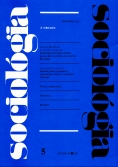Kohabitácie ako jedna z foriem partnerského spolužitia obyvateľstva Slovenska
Cohabitations as One Forms of Partners Living Together in Slovakia
Author(s): Jozef Mládek, Jana ŠiročkováSubject(s): Social Sciences
Published by: Sociologický ústav - Slovenská akadémia vied
Keywords: Cohabitation; family behaviour; socio-cultural characteristics
Summary/Abstract: Cohabitation as One Form of Partners Living Together in Slovakia. Changes in demographic behaviour – „the second demographic revolution“, occurred in the second half of 20th century. These changes are most significantly manifested in family behaviour, in the processes connected with the establishment and dissolution of families and with their reproductive function. Family types have diversified. In spite of the strong influence of tradition, there are three changes in family behaviour, which have arisen in Slovakia. The nuclear family still prevails but at the same time the number of cohabitations as well as the amount of children born out of wedlock has increased. A significant number of people prefer single child families. The term cohabitation refers to two adults of the opposite sex that live together in a common household for a longer time (as husband and wife) without being married. His/her/their children may also be living together with them. The number of cohabitations in Slovakia had extended. There is a significant correlation between cohabitation and some socio-cultural characteristics. According to the analysis of nationality-structure, there are relatively smaller proportions of cohabitansts from Slovak, Rusin and Ukrainian nationalities. Higher ratios are from Hungarian, Roma and Czech nationalities. Comparison of religion-structure reveals that the members of the Roman-Catholic, Greek-Catholic and Lutheran church have a reserved or disapproving attitude. On the other hand, people without religious beliefs, people whose religious attitudes were not discovered, and members of Orthodox and Reformed church demonstrated a relatively higher representation of cohabitants. The highest rate of cohabitation exists among people with basic and vocational education. There are less cohabitants with secondary and university education. The highest proportions of cohabiting couples are in two regions – Banska Bystrica and Košice. The lowest rates are in the Žilina and Prešov regions. The regions of Nitra and Trnava are in the middle. And in the Bratislava region and the Trenčín region the level of cohabitation keeps shifting. Similar differences also occur on the county level. Regional or spatial differences depend on nationality and religious structure.
Journal: Sociológia - Slovak Sociological Review
- Issue Year: 2004
- Issue No: 5
- Page Range: 423-454
- Page Count: 32
- Language: Slovak

